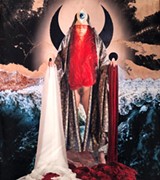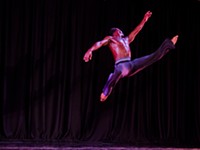[
{
"name": "500x250 Ad",
"insertPoint": "5",
"component": "15667920",
"parentWrapperClass": "",
"requiredCountToDisplay": "1"
}
]
Last Saturday evening a crowd of art devotees gathered to watch a woman give birth to herself. She emerged from behind a curtain dressed like a priestess in flowing veils, nude fishnets, and shimmering pumps, with a giant third-eye headdress strapped to her brow. The front of her stockings protruded with a volume of scarves, simulating a baby bump. Over the course of her performance she called upon the elements, ancestors, spirit guides, archangels, and ascended masters, performed a cosmic dance with a mannequin, used a blade to cut off all of her clothing, anointed herself with her own menstrual blood, and buried herself in a mound of soil. When she re-emerged, minutes later, she was ecstatic.
The performance was the culmination of Megan Joy May's year-long art residency at Flower City Arts Center, and it accompanied "Myths of the Sacred Wound," an exhibit of her photographic self-portraiture, which is on view through April 27 at the center's Photography & Digital Arts Gallery.
There's not a lot of performance art going on in Rochester, and what I have seen in the past several years was in a similar conceptual vein: photographer Tina Starr performed acts of catharsis and confrontation to small crowds, reclaiming her body while displaying it on her own terms. Portraiture (self- and otherwise) is inherently performative, so the leap from photography to performance art is perhaps not a large one.
It feels like a cliché to call May's performance courageous, but it wouldn't be false. A female-bodied individual deciding the terms of how her body is viewed and consumed is an act of confrontation. Making "dirty" menstrual blood a public topic, let alone smudging it on your face and body, is defiant as hell. And making a sweep of eye contact with the audience while nude before descending into the earth is one hell of a goddess move (just ask Persephone or Inanna).
Performance art is also an act of trust, a sacred covenant formed between the player and the witness. It's not meant to be comfortable, but provocative, and it's arguably the most difficult art to approach.
Even May's photography is treated as performance: with few exceptions she functions as both photographer and model. Her work runs the gamut from boudoir-esque explorations of her own sensuality to more formal-looking, staged portraits of her holding a baby doll to her breast, with a shimmering red cloth (representing blood) suspended from her vulva to the mound of dirt she stands on. She's created photo-collage self-portraits that allude to tarot cards (in this show, The High Priestess and The Empress) and are packed with elemental and spiritual symbolism. And she experiments with creating animated gifs from selfies on social media.
Woman-centered, witchy, woo-woo practices have seen a resurgence among Millennials and in the younger generation (whatever it is we're calling it), and it's not just a passing identity fad. There are deeper-than-ever dives into the nuances of tarot and astrology specifically, and women and femmes have begun to identify with specific goddess or heroine archetypes, the femininity of nature and of the Earth, and spirit guides.
The interest in, and hunger for, re-awakening feminine-powered, elemental and spiritual arts that began during the sexual revolution is experiencing a second wave. And just like the first wave, it's experiencing a pushback from the patriarchy. Whether women dabble in the practices -- as symbolic anchors of power in a world that denies them equity -- or take it all seriously, there's a knee-jerk tendency to deride and dismiss it. That's cruel, given that it's doing no harm, is arguably no more ridiculous than better-respected religions and rituals, and can serve as a means of self-actualizing. But May sees the ridicule as echoes of something more sinister: when the patriarchy seized power and defended its supremacy with bloodshed.
A great deal of violence against women has happened throughout history, May said in an interview. And part of women's internalized misogyny comes from "an epigenetic fear that has kept us back, kept us to want to be safe," she says. "There's a biological imperative to survive."
But she says she feels tenuous about the concept of gender polarity, and she is sensitive to trans people and the bad social constructs they deal with. "Part of my reconciliation with the feminine is that the feminine doesn't belong to me or just to bleeding bodies," May says. "The reason that women, people of color, and all marginalized people could be 'othered' is they were set apart from a central understanding of what it is to be human: white and male. That's not nature's truth."
And with the widespread, modern concept of the divine as strictly masculine, anything outside of that is inherently diminished. And it's heretical to challenge that, she says.
During her residency, May has given many workshops and lectures, and she has one coming up on April 18. She talks like a professor, guru, motivational speaker, and best friend, all rolled into one. She's joyful, bright, direct, and engaging in conversations about feminist theory, old world cultural practices, and intuitive philosophies about the mind and body. May recently turned 34, and she says she's interested in mentoring creative women in their 20's and 30's.
Individual healing is collective healing, she says. "If I do healing on myself, I'm healing my family, my bloodline. If I'm healing myself and being vocal about how that's happening, and I'm modeling that, I'm healing my community, for the people who need to see that."
In her artist statement, May explains that she sees humanity's violence and suffering as a result of fear -- "fear of self, fear of love, fear of death, fear of fear itself" -- and that fear keeps us from connecting to love of the self and others.
Her current work, she says, "talks about the shared wound of humanity that we believe we're separate from the universe, from the source, and especially now in contemporary culture, we believe we're separate from nature. White Western culture especially has lost any sense of mythology, of our interrelatedness, and our interdependent-ness within a cosmology of continuous expanding, change, and regeneration."
Healing the sacred wound of self-hatred through self-acceptance leads to unconditional love and an evolution to higher dimensions, she says. "And I'm here for that, I'm here for all of that."
Both her performance art and photographic work provide one answer to the question: what does the "female gaze" look like? The centuries-old concept of the male gaze isn't going anywhere quickly. In art and wider culture, how the feminine is portrayed is still dominated by its consumable-ness to male attention. In recent decades, there's been a drive -- specifically led by photographers, including Cindy Sherman, Monika Mogi, and Pixy Liao -- to explore the self and other femme-identifying individuals through a lens other than male desire.
So May's work falls into the legacy of attempts to shift the gaze. But her artistic concerns are less about dealing with the patriarchy directly than they are about dismantling and healing internalized misogyny. May's work, she says, seeks to reconcile mysticism and spiritual practices with production, asking the question: "What am I making in the world?" and discovering how that doesn't have to be attuned to the inner patriarchal gaze.
Megan Joy May provided us with some playlists:
"These playlists accumulated over my residency informing much of my personal movement practice, contributing to my growing feelings of soft empowerment. "Femme Powerful" is definitely a more fierce and raunchy line-up of songs that I like to shake my ass to. "Femme Sex and Chill" was created more for softening into my sensual feelings especially in terms of sharing intimate time with another, prioritizing how I want to feel during such an interaction."
Latest in Art
More by Rebecca Rafferty
-

Beyond folklore
Apr 4, 2024 -

Partnership perks: Public Provisions @ Flour City Bread
Feb 24, 2024 -

Raison d’Art
Feb 19, 2024 - More »






